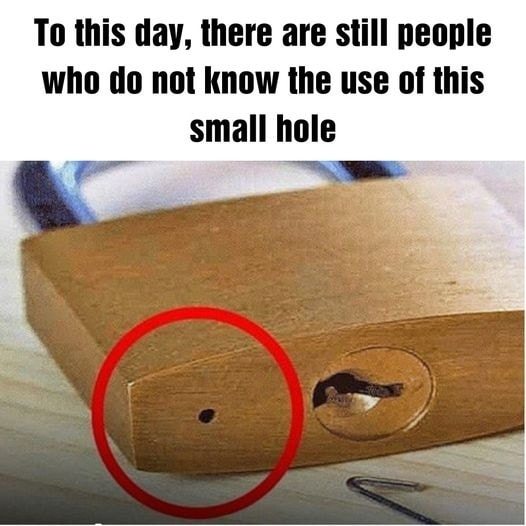ADVERTISEMENT
What is That Little Hole At The Bottom of a Padlock For?
If you’ve ever taken a close look at a padlock, you might have noticed a small, seemingly insignificant hole at the bottom of the lock body. This hole isn’t just a design feature or a random extra detail—it actually serves a very important purpose. So, what is that little hole at the bottom of a padlock for? Let’s explore this often-overlooked feature and uncover its function.
The Purpose of the Hole at the Bottom of a Padlock
The small hole at the bottom of a padlock is primarily designed to drain moisture. It’s a clever feature that helps protect the lock’s internal components from rust and corrosion, which are common issues when padlocks are exposed to outdoor elements.
1. Preventing Rust and Corrosion
Padlocks, especially those used outdoors, are frequently exposed to rain, snow, and humidity. When moisture builds up inside the lock, it can cause the metal parts to rust, making the lock harder to operate and shortening its lifespan. The small hole allows excess moisture to drain out, keeping the internal mechanisms of the lock dry and functioning smoothly.
This feature is especially helpful for locks that are used in areas with high humidity or in environments where condensation is common (for example, near a body of water or in damp outdoor storage). Without this drainage hole, the moisture could stay trapped inside, causing the lock to seize up over time.
2. Allowing for Lubrication
Another important function of the hole is to allow for the application of lubricant. When you want to lubricate your padlock (which is essential to keep it in working order), you can apply a lubricant through this hole. The lubricant will then travel to the internal parts of the lock, ensuring that the pins and other moving components are properly greased. This makes the lock easier to operate and reduces wear and tear on the mechanism.
Lubrication is important for preventing the lock from getting stuck or jammed, especially when used in cold weather, where metal can contract and freeze. Regular lubrication can extend the life of your padlock and keep it working smoothly.
3. Cleaning the Lock
In addition to draining moisture and allowing lubrication, the hole can also help with cleaning the lock. If dirt, dust, or debris gets trapped inside the lock, the hole can allow you to spray cleaning solutions or compressed air into the padlock to clear out any particles that might impede its function.
By regularly cleaning the padlock through this hole, you can ensure that the internal mechanisms remain free of contaminants that could cause issues, such as jamming or malfunctioning.
For Complete Cooking STEPS Please Head On Over To Next Page Or Open button (>) and don’t forget to SHARE with your Facebook friends
Are All Padlocks Designed with This Hole?
Not all padlocks feature a hole at the bottom. The presence of a drainage hole is more common in outdoor padlocks that are designed to withstand the elements. For instance, high-quality weatherproof or marine-grade locks are more likely to have this feature because they are intended to be used in environments where moisture and weather exposure are more frequent.
On the other hand, indoor locks or decorative padlocks, which are not exposed to harsh weather conditions, may not have this feature. However, it’s always a good idea to check for any instructions or guidelines from the manufacturer about maintaining your lock’s condition and whether or not lubrication or cleaning is necessary.
What Happens If the Hole Gets Blocked?
If the drainage hole becomes blocked—whether by dirt, rust, or other debris—the lock may start to experience issues such as difficulty opening, rusting, or stiff operation. It’s important to periodically inspect the hole and ensure that it’s clear. If it becomes blocked, you can try cleaning it gently with a small wire or toothpick, but be careful not to damage the lock’s components.
Other Interesting Features of Padlocks
While the small hole at the bottom serves a key purpose, padlocks are often designed with other interesting features to improve their durability and function. Here are a few other notable aspects to keep in mind:
